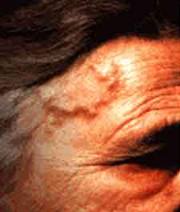CidpUsa.Org
Autoimmune Diseases Web
Overview:
Temporal arteritis, known as giant cell arteritis, is an inflammatory
condition affecting the medium-sized blood vessels that supply the head, eyes,
and optic nerves. The disease usually affects those over 60 years of age
and causes the vessels in the temple and scalp to become swollen and tender.
Women are approximately 4 times more likely to suffer from this disease then
men.
a thick temporal artery Visible on the forehead.
The major concern with temporal arteritis is vision loss, although if
allowed to progress, it may affect arteries in other areas of the body.
This condition is potentially vision threatening, however, if treated
promptly, permanent vision loss can be prevented. Vision is
threatened when the inflamed arteries obstruct blood flow to the eyes
andoptic nerves. If untreated, permanent vision loss can occur from
oxygen deprivation to the retina and optic nerve.Temporal Arteritis
(Giant Cell Arteritis) can make you Blind

Signs and Symptoms
Patients with temporal arteritis usually notice visual symptoms in one eye at first, but as many as 50% may notice symptoms in the fellow eye within days if the condition is untreated.
Headache
- Tenderness of scalp (combing hair may be painful)
- Pain in temple area (may be excruciating)
Transient blurred vision
Loss of appetite
Fever
Fatigue
Depression
Drooping lid
Double vision
Sore neck
Jaw soreness, especially when chewing food
-
Detection and Diagnosis
Looking in the Fundus of the EYE
 You see a pale disc in the center
You see a pale disc in the center
When temporal arteritis is suspected, the doctor will order blood tests including a erythrocyte (red blood cell) sedimentation rate (ESR) and C-reactive protein test. The the erythrocytes to collect in the bottom of a test tube. The sediment layer of erythrocytes is measured in millimeters and recorded. An abnormally high ESR is indicative of active inflammation.
Please go to next page of treatment of Temporal arteritis